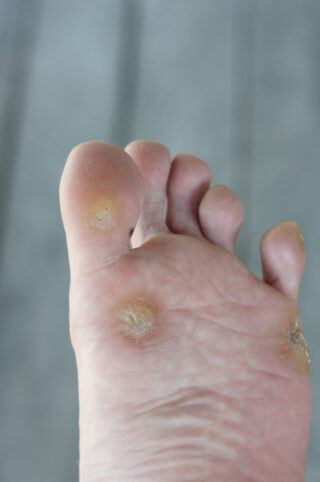
Largo Foot and Ankle Health Center
1450 Mercantile Lane
Suite 151
Upper Marlboro, MD 20774

More Podiatry Foot Care Articles
Corns and Calluses: Part One

A corn is a form of callus that is protective thickening of the skin on a bony, knobby portion of a toe. At the center of a corn is often a very dense knot of skin called a core, which is located over the area of greatest friction or pressure. This core can put pressure on a nerve and cause sharp pain.
Firm, dry corns that form on the upper surfaces of the toes are called hard corns. Pliable, moist corns that form between the toes are called soft corns. In most cases, corns develop when the foot has been squeezed into a shoe that has a very narrow toe area. Less often, corns develop on deformed toes that cannot fit comfortably into regular shoes.
Symptoms
On the feet, a small corn or callus may not cause any symptoms. However, a large, bulky corn or callus can cause foot pain and difficulty walking.
After prolonged irritation, a discolored area (brown, red or black) may develop under a large corn or callus. This discoloration is caused by a small amount of bleeding in the space between thick and normal skin. In severe cases, the thick and normal skin may separate, exposing the area to possible infection, especially in people with diabetes.
Diagnosis
Your podiatrist/doctor will ask about your shoes, because shoes with narrow toes are more likely to cause corns. He or she also will ask about your foot history and your history of other medical problems, including diabetes and circulation problems. Some types of foot problems can alter the mechanics of the foot, causing abnormal pressure on certain areas and leading to calluses. Also, any previous surgery or trauma to the feet may affect the structure and alignment of foot bones, increasing the risk of calluses.
To assess whether your corns is related to foot abnormalities, your podiatrist will inspect your feet for toe deformities, structural problems of the bones, poor bone alignment and problems related to an abnormal way of walking (gait). If your doctor finds some abnormality during this part of the foot exam, he or she may suggest a specific type of padding, shaving or shoe insert to help prevent your corns and calluses from returning or causing as much discomfort.
Next month’s article will focus on the prevention and treatment of corns.

















